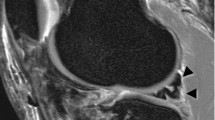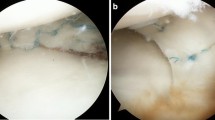Abstract
Objectives
To assess the reliability and diagnostic accuracy of qualitative evaluation of apparent diffusion coefficient (ADC) mapping with magnetic resonance imaging (MRI) in differentiating between complete and partial anterior cruciate ligament (ACL) tears.
Methods
This prospective study protocol was approved by the institutional ethics review board and informed consent was obtained from all the patients. Eighty-five patients (35 women and 50 men, mean age 34.1 years) with recent (<4 months) knee trauma with suspected ACL injury underwent conventional MRI (T1-weighted and T2-weighted sequences with fat saturation) associated with ADC mapping. MR images were read qualitatively without and then with ADC mapping by three radiologists, with analysis of direct signs of a traumatic ACL tear and a second-reading. Dynamic X-rays (43 patients) or arthroscopies (42 patients) were used as reference standards.
Results
For complete ACL tear diagnosis (67 patients), sensitivity and specificity were 87% and 50% respectively with conventional MRI, and 96% and 94% respectively with ADC mapping (P < 0.01 for specificity). Inter-observer correlations between musculoskeletal radiologists were almost perfect (κ = 0.81) with ADC mapping and fair with conventional MRI on the second-reading.
Conclusions
ADC mapping associated with conventional MR sequences is a reproducible method to better differentiate complete and partial ACL tears.
Key Points
• MRI is widely used for assessing the problematic knee
• Additional diffusion-weighted sequences help differentiate between complete and partial ACL tears
• DW-MRI for ACL requires a reader-dependent learning curve
• Reliable visualisation of complete ACL tears allows more appropriate management of patients





Similar content being viewed by others
Abbreviations
- ACL:
-
Anterior cruciate ligament
- DW-MRI:
-
Diffusion-weighted magnetic resonance imaging
- ADC:
-
Apparent diffusion coefficient
References
McCauley TR, Moses M, Kier R et al (1994) MR diagnosis of tears of anterior cruciate ligament of the knee: importance of ancillary findings. AJR Am J Roentgenol 162:115–119
Chen WT, Shih TT, Tu HY et al (2002) Partial and complete tear of the anterior cruciate ligament. Acta Radiol 43:511–516
Gentili A, Seeger LL, Yao L et al (1994) Anterior cruciate ligament tear: indirect signs at MR imaging. Radiology 193:835–840
Lawrance JA, Ostlere SJ, Dodd CA (1996) MRI diagnosis of partial tears of the anterior cruciate ligament. Injury 27:153–155
Robertson PL, Schweitzer ME, Bartolozzi AR et al (1994) Anterior cruciate ligament tears: evaluation of multiple signs with MR imaging. Radiology 193:829–834
Tung GA, Davis LM, Wiggins ME et al (1993) Tears of the anterior cruciate ligament: primary and secondary signs at MR imaging. Radiology 188:661–667
Bomberg BC, McGinty JB (1990) Acute hemarthrosis of the knee: indications for diagnostic arthroscopy. Arthroscopy 6:221–225
DeHaven KE (1980) Diagnosis of acute knee injuries with hemarthrosis. Am J Sports Med 8:9–14
Noyes FR, Bassett RW, Grood ES et al (1980) Arthroscopy in acute traumatic hemarthrosis of the knee. Incidence of anterior cruciate tears and other injuries. J Bone Joint Surg Am 62(687–95):757
Tsai KJ, Chiang H, Jiang CC (2004) Magnetic resonance imaging of anterior cruciate ligament rupture. BMC Musculoskelet Disord 5:21
Umans H, Wimpfheimer O, Haramati N et al (1995) Diagnosis of partial tears of the anterior cruciate ligament of the knee: value of MR imaging. AJR Am J Roentgenol 165:893–897
Yao L, Gentili A, Petrus L et al (1995) Partial ACL rupture: an MR diagnosis? Skeletal Radiol 24:247–251
Van Dyck P, Vanhoenacker FM, Gielen JL et al (2011) Three tesla magnetic resonance imaging of the anterior cruciate ligament of the knee: can we differentiate complete from partial tears? Skeletal Radiol 40:701–707
Yoon YC, Kim SS, Chung HW et al (2007) Diagnostic efficacy in knee MRI comparing conventional technique and multiplanar reconstruction with one-millimeter FSE PDW images. Acta Radiol 48:869–874
Logan M, Dunstan E, Robinson J et al (2004) Tibiofemoral kinematics of the anterior cruciate ligament (ACL)-deficient weightbearing, living knee employing vertical access open “interventional” multiple resonance imaging. Am J Sports Med 32:720–726
Niitsu M (2001) Kinematic MR imaging of the knee. Semin Musculoskelet Radiol 5:153–157
Kwon JW, Yoon YC, Kim YN et al (2009) Which oblique plane is more helpful in diagnosing an anterior cruciate ligament tear? Clin Radiol 64:291–297
Le Bihan D, Breton E, Lallemand D et al (1988) Separation of diffusion and perfusion in intravoxel incoherent motion MR imaging. Radiology 168:497–505
Baur A, Stabler A, Bruning R et al (1998) Diffusion-weighted MR imaging of bone marrow: differentiation of benign versus pathologic compression fractures. Radiology 207:349–356
Friedrich KM, Mamisch TC, Plank C et al (2010) Diffusion-weighted imaging for the follow-up of patients after matrix-associated autologous chondrocyte transplantation. Eur J Radiol 73:622–628
Garces GL, Perdomo E, Guerra A et al (1995) Stress radiography in the diagnosis of anterior cruciate ligament deficiency. Int Orthop 19:86–88
Kobayashi S, Terayama K (1993) Quantitative stress radiography for diagnosis of anterior cruciate ligament deficiency. Comparison between manual and instrumental techniques and between methods with knee flexed at 20 degrees and at 90 degrees. Arch Orthop Trauma Surg 112:109–112
Mononen T, Alaranta H, Harilainen A et al (1997) Instrumented measurement of anterior-posterior translation in knees with chronic anterior cruciate ligament tear. Arch Orthop Trauma Surg 116:283–286
Beldame J, Bertiaux S, Roussignol X et al (2011) Laxity measurements using stress radiography to assess anterior cruciate ligament tears. Orthop Traumatol Surg Res 97:34–43
Fleiss JL (1981) Statistical methods for rates and proportions, 2nd edn. Wiley, New York
Landis JR, Koch GG (1977) The measurement of observer agreement for categorical data. Biometrics 33:159–174
Le Bihan D, Turner R, Douek P et al (1992) Diffusion MR imaging: clinical applications. AJR Am J Roentgenol 159:591–599
Cieszanowski A, Anysz-Grodzicka A, Szeszkowski W et al. (2012) Characterization of focal liver lesions using quantitative techniques: comparison of apparent diffusion coefficient values and T2 relaxation times. Eur Radiol. doi:10.1007/s00330-012-2519-x
Van Dyck P, De Smet E, Veryser J et al (2012) Partial tear of the anterior cruciate ligament of the knee: injury patterns on MR imaging. Knee Surg Sports Traumatol Arthrosc 20:256–261
Krampla W, Roesel M, Svoboda K et al (2009) MRI of the knee: how do field strength and radiologist’s experience influence diagnostic accuracy and interobserver correlation in assessing chondral and meniscal lesions and the integrity of the anterior cruciate ligament? Eur Radiol 19:1519–1528
Nishikawa H, Imanaka Y, Sekimoto M et al (2010) Verification bias in assessment of the utility of MRI in the diagnosis of cruciate ligament tears. AJR 195:W357–W364
Barrack RL, Buckley SL, Bruckner JD et al (1990) Partial versus complete acute anterior cruciate ligament tears. The results of nonoperative treatment. J Bone Joint Surg Br 72:622–624
Bellier G, Christel P, Colombet P et al (2004) Double-stranded hamstring graft for anterior cruciate ligament reconstruction. Arthroscopy 20:890–894
Acknowledgments
We thank all the patients who agreed to take part in this study. We also thank Irène Boulloche for her editorial assistance in the preparation of this manuscript.
Author information
Authors and Affiliations
Corresponding author
Appendix
Appendix
Rights and permissions
About this article
Cite this article
Delin, C., Silvera, S., Coste, J. et al. Reliability and diagnostic accuracy of qualitative evaluation of diffusion-weighted MRI combined with conventional MRI in differentiating between complete and partial anterior cruciate ligament tears. Eur Radiol 23, 845–854 (2013). https://doi.org/10.1007/s00330-012-2633-9
Received:
Revised:
Accepted:
Published:
Issue Date:
DOI: https://doi.org/10.1007/s00330-012-2633-9




